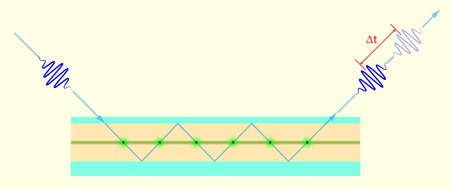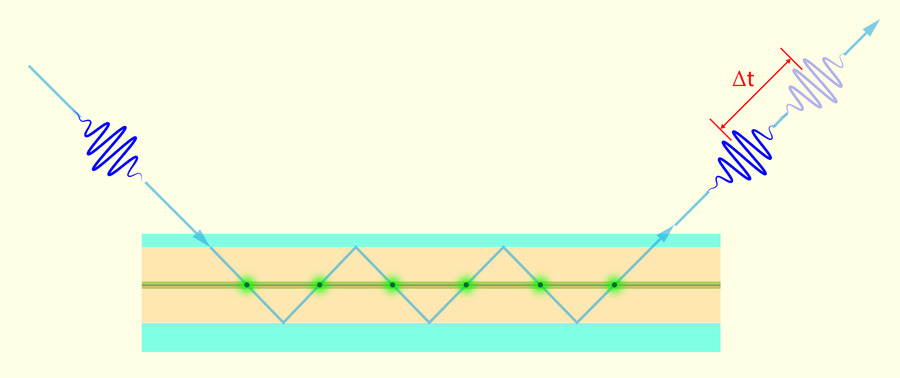Cavity with Iron Nuclei Slows Down X Rays
In vacuum, the propagation of photons proceeds with the same speed for each color (or frequency) of light. A laser pulse, corresponding to a broad range of frequencies, will thus propagate in vacuum without any deformation or delay. However, if the pulse enters a medium with an index of refraction that depends strongly on the frequency, then some colors will travel faster than others, causing a change in the overall pulse. In some cases this dispersion can slow down light [1,2], so that photons at the end of the pulse catch up to those at the front of the pulse. In this way, slow light propagation can yield higher densities of photons, i.e., higher intensities, inside the medium, which can be used to explore nonlinear and/or quantum effects in the light-matter interactions. Slow light has been studied extensively at visible frequencies, but recent work has begun to explore related phenomena in x rays [3]. Kilian Heeg of the Max Planck Institute for Nuclear Physics in Heidelberg, Germany, and his colleagues have measured slow x rays in a dispersive system [4]. The team directed x rays from a synchrotron source into a specially designed cavity and recorded a time delay in the outgoing light, which implied a speed decrease by 4 orders of magnitude. Further progress will help to concentrate high-energy light for nonlinear x-ray optics with possible applications, e.g., in super-resolved imaging or in quantum optics and quantum cryptography in the x-ray regime.
Strong dispersion is often associated with a narrow resonance. This is because light strongly interacts with a medium or cavity when its frequency approaches a resonance set by the atoms in the medium or by the geometry of the cavity. This interaction alters how fast different frequencies can travel through the medium. The narrow resonance of a Fabry-Pérot cavity produces this sort of strong dispersion, which can be used to compress laser pulses and thereby increase their intensity. To control these sorts of effects, physicists have learned ways to engineer narrow resonances, particularly in atomic media [5]. For example, a laser can be shone on an atomic gas in order to turn off the absorption at one of its atomic resonances. This so-called electromagnetically induced transparency results in resonant light (from a second laser) slowing down as it passes through the medium. Certain groups have recorded speeds below that of a biker [6], and it has even been possible to bring photons to a complete halt and store them in an atomic vapor [7,8], which could be used in future quantum memory devices.
Extending such experiments from the visible range of the spectrum into the x-ray regime will open new doors of exploration of light-matter interactions. However, performing experiments with x rays is not as easy as with visible light. First, x-ray sources of radiation are less common than commercial lasers. Second, x-ray mirrors are difficult to produce and only work at grazing incidence. Furthermore, the manipulation of the spectrum of the incident radiation requires novel techniques to be put together.
In their experiment [4], Heeg et al. used the European Synchrotron Radiation Source in Grenoble, which has a higher photon flux than common radioactive sources. In order to slow down incoming x rays, the team used a cavity composed of several nanometer-thick layers. The top and bottom layers are made with the metal palladium, which acts as a reflecting mirror for x rays coming in at grazing incidence. In between these mirrors, the team sandwiched a thin layer of iron between two carbon layers (see Fig. 1). The iron nuclei have a narrow resonance at 14.4 kilo-electron-volts. The researchers tuned the angle of incidence of the x rays to match the cavity resonance [9]. The cooperative response of the many iron nuclei results in a broadened resonance with a steep dispersion. X rays with the resonance frequency enter the cavity, interact with the iron atoms and bounce several times before escaping, making them arrive later at the detector than nonresonant x rays that reflect off the cavity without entering it.
To observe the delay is not easy to do because x-ray sources are less controllable as lasers in the visible range. If the incoming laser pulse is broader than the resonance, then the outgoing light pulse will be deformed, thus obscuring the delay signal. In order to generate a sufficiently narrow pulse, Heeg et al. use a clever combination of filters in the frequency and time domain. They combine a frequency filter using absorption by an iron-rich foil with a fast chopper to detect the delay in the pulse arrival time. By tuning the frequency of the incident pulse, the researchers showed that x-ray photons were delayed by up to 35 nanoseconds when tuned to the resonance of the nuclei in the cavity. Combining this delay with an estimate of the distance x rays propagate through the cavity, Heeg et al. determined that the speed of propagation was reduced by 4 orders of magnitude in the cavity.
This experiment illustrates the extension of concepts used in atomic physics into the regime of nuclear physics with x rays. Similar to the transition from lamps to lasers in the 1960s, important efforts are under way to increase the brightness of sources in the x-ray regime, with free-electron lasers [10] and other novel types of sources. These advances should pave the way for nonlinear optics and even quantum optics in the x-ray regime. As an example, researchers might be able to use two-photon correlations to improve the resolution in x-ray images. Or, they could take advantage of the higher detection efficiency of x rays (as compared to longer wavelengths) to make quantum cryptography more robust. These future applications may benefit from cavities and other materials that enhance the interaction of light and matter by slowing down the propagation of x rays. The scheme used by Heeg et al. is therefore an excellent candidate to explore the x-ray frontier.
This research is published in Physical Review Letters.
References
- M. Fleischhauer, A. Imamoglu, and J. P. Marangos “Electromagnetically Induced Transparency: Optics in Coherent Media,” Rev. Mod. Phys. 77, 633 (2005)
- R. W. Boyd and D. J. Gauthier, “Slow and fast light,” in Progress in Optics, Vol. 43, edited by Emil Wolf (Elsevier, Amsterdam, 2002), p. 497[Amazon][WorldCat]
- R. Röhlsberger, H.-C. Wille, K. Schlage, and B. Sahoo, “Electromagnetically induced Transparency with Resonant Nuclei in a Cavity,” Nature 482, 199 (2012)
- Kilian P. Heeg et al., “Tunable Subluminal Propagation of Narrow-band X-Ray Pulses,” Phys. Rev. Lett. 114, 203601 (2015)
- A. Kasapi, Maneesh Jain, G. Y. Yin, and S. E. Harris, “Electromagnetically Induced Transparency: Propagation Dynamics,” Phys. Rev. Lett. 74, 2447 (1995)
- L. V. Hau, S. E. Harris, Z. Dutton, and C. H. Behroozi, “Light Speed Reduction to 17 Metres per Second in an Ultracold Atomic Gas,” Nature 397, 594 (1999)
- C. Liu, Z. Dutton, C. H. Behroozi, and L. V. Hau, “Observation of Coherent Optical Information Storage in an Atomic Medium Using Halted Light Pulses,” Nature 409, 490 (2001)
- D. F. Phillips, A. Fleischhauer, A. Mair, R. L. Walsworth, and M. D. Lukin, “Storage of Light in Atomic Vapor,” Phys. Rev. Lett. 86, 783 (2001)
- R. Röhlsberger, K. Schlage, B. Sahoo, S. Couet, and R. Rüffer, “The Collective Lamb Shift in Single Photon Superradiance,” Science 328, 1248 (2010)
- European XFEL, http://www.xfel.eu/Figure.





